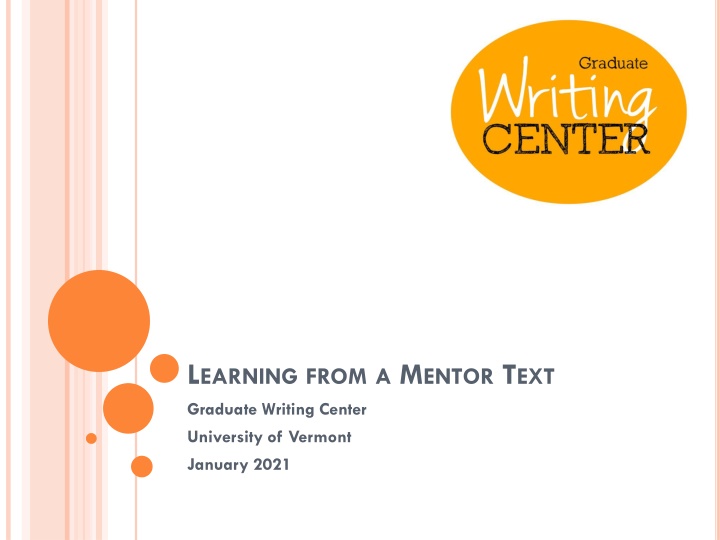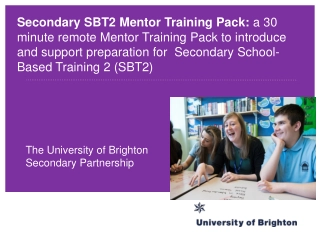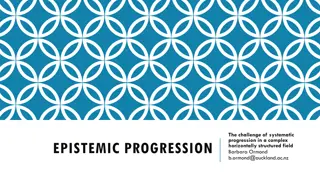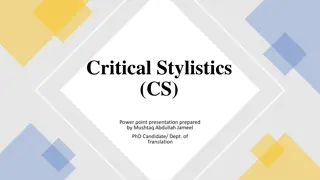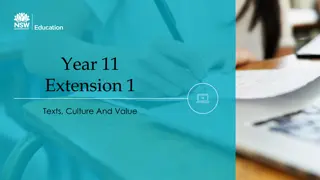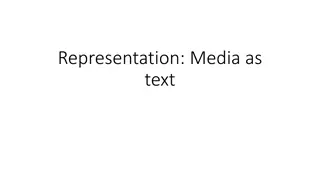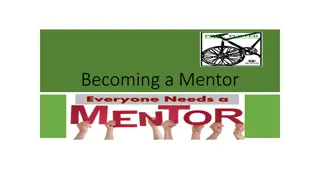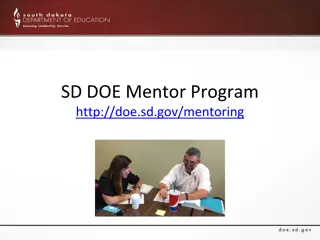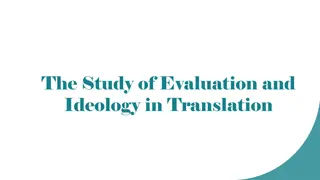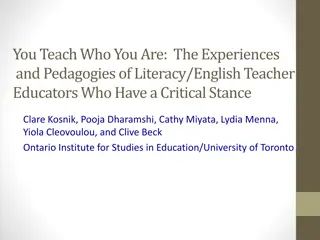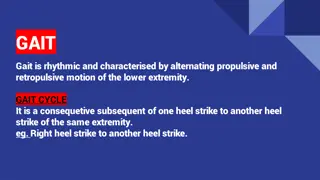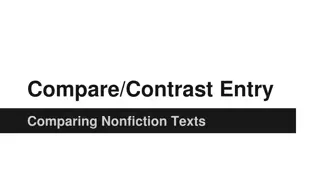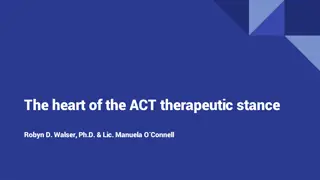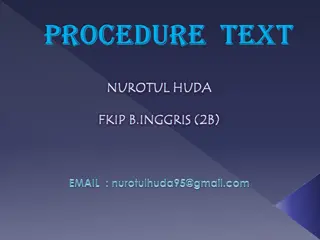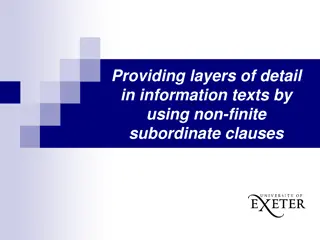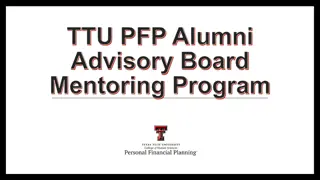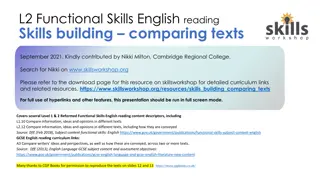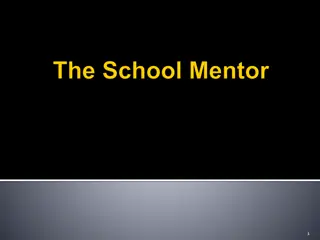Analyzing Mentor Texts: Structure, Progression, Stance, Relationship
Mentor texts serve as valuable tools for writers to enhance their own writing skills. This analysis focuses on dissecting mentor texts, examining their structure, progression, authorial stance, and audience relationship. By exploring these elements, writers can gain insights into effective writing strategies and stylistic expectations across different genres.
Download Presentation

Please find below an Image/Link to download the presentation.
The content on the website is provided AS IS for your information and personal use only. It may not be sold, licensed, or shared on other websites without obtaining consent from the author.If you encounter any issues during the download, it is possible that the publisher has removed the file from their server.
You are allowed to download the files provided on this website for personal or commercial use, subject to the condition that they are used lawfully. All files are the property of their respective owners.
The content on the website is provided AS IS for your information and personal use only. It may not be sold, licensed, or shared on other websites without obtaining consent from the author.
E N D
Presentation Transcript
LEARNING FROM A MENTOR TEXT Graduate Writing Center University of Vermont January 2021
TODAYS GOALS Make observational notes about sequence and structure, rhetorical situation (purpose, audience-author relationship), language, and style Create a rhetorical outline of (a portion of) a mentor text e.g., the introduction to a proposal, seminar paper, or thesis chapter; the results and discussion section of an article Share findings and discuss how your rhetorical outline can help you storyboard your own project and what your observations teach you about rhetorical and stylistic expectations for this genre.
WHAT IS A MENTOR TEXT AND WHEN DO YOU NEED ONE? Mentor texts are any texts that you can learn from that can lift and inform and infuse [your] own writing. Ralph Fletcher, Mentor Author, Mentor Texts Seek out a mentor text when you venture into a genre that s new to you as a reader (few of us read a thesis or grant proposal before writing our first!). Seek out a mentor text when you venture into a genre that s new to you as a writer (we read lots of scholarly and scientific articles for what they say without paying attention to how they are written).
YOUR PROJECT, QUESTIONS, & MENTOR TEXT Respond in the chat! What is your project? What mentor text did you bring for today? What do you hope to learn from it?
MENTOR TEXT ANALYSIS: STRUCTURE & PROGRESSION From your mentor text, make observational notes: How many sections does the text have? How are the sections, or the paragraphs within a section, ordered and what is the logic behind that order? What is the main idea (puzzle, gap, claim, problem, question) of this text? Where does it first appear? What work does each section do in articulating, demonstrating, advancing, or complicating the text s main idea?
MENTOR TEXT ANALYSIS: AUTHORIAL STANCE & AUDIENCE RELATIONSHIP Where do you sense the writer s presence? Consider not only I or We but how the writer signals attitude and personality through emphasis and urgency, praise or criticism, softeners and hedges, wit and humor etc. How does the writing orient readers? Consider section headings, use of questions, signposts (reminders of where we are ), forecasting (pointing to where we are going ), and other guides that help a reader navigate the text. What level of knowledge by the reader is assumed? What terms are defined? Which are assumed the reader knows? How many references are used? To what extent does the writer respond to, evaluate, build on, counter or otherwise interact with other referenced authors? To what extent does the writer report on or cite other scholarship without visible interaction? Does the writer cite/build on their own previously published work?
MENTOR TEXT ANALYSIS: LANGUAGE, ILLUSTRATION, & STYLE Look at the paragraphs in a section. What is the main idea in each? Where does it appear? How does the writer develop tension or a sense of progression/story in these paragraphs? How long are the sentences? How complex? How do the sentences express ideas? Where is the subject? What kinds of verbs are used? Is the voice passive or active? If a mix of both, can you discern why in each instance? Circle the verbs. Are they past-tense or present-tense? What do they tell you about reporting verbs for this genre? What rhetorical or poetic devices (alliteration, allusion, analogy, double entrendre etc.) does the writer use? Are there figures and graphs? How do they relate to the text?
PAUSE: WHAT HAVE YOU LEARNED SO FAR? Respond in the chat or raise your hand to share!
RHETORICAL OUTLINE You are probably used to summarizing what a text says. In a rhetorical outline, you examine how a mentor works rhetorically paragraph to paragraph to meet its audience s needs and advance its authors goals creating an outline/skeleton view of what each part does (rather than what each part says)
RHETORICAL OUTLINE For example, a rhetorical outline of an article introduction about MRI imaging for Physical Therapy patients with Parkinson s: Par 1: Introduces the problem and the question of whether a therapy useful in other diseases could be successful here Par 2: Explains the therapy and summarizes how it has worked with other conditions Par 3: Spotlights the gap lack of work to date on MRI imaging in Parkinson s clinical settings and introduces the researchers focus/question.
RHETORICAL OUTLINE For example, a rhetorical outline of an Education/student development seminar paper on improved academic advising for first-gen college students: Par 1: Introduces the context creating need and briefly defines first- generation college student Par 2: Maps the paper to come: first, personal narrative; then analysis of personal narrative through the academic advising literature to identify three key challenges that expanded advising could address. (Foreshadows but doesn t yet name the three key challenges) Par 3: Subheading signals start of personal narrative with first encounter with college and advising support
RHETORICAL OUTLINE Create a paragraph by paragraph outline: What does this paragraph do? e.g. lay out a research terrain; identify a gap; propose a course of action; sequence and flesh out a research pipeline etc. How does this paragraph follow from the previous paragraph? How does it prepare for the next paragraph to come? * You can create your outline with annotations in the margins of the text or, in list form, on a separate sheet of paper or in a Word or Google document
WITH YOUR MENTOR TEXT OBSERVATIONAL NOTES AND RHETORICAL OUTLINE YOU CAN ... Storyboard and rough out your own draft. Refer to your mentor text and analysis when you face a particular question in your own writing such as whether to define a term or how to hedge or boost a claim. Create a rhetorical outline and analysis of your own completed or in-progress draft to understand how your draft works and could work better to meet reader needs and advance your goals.
BREAKOUT ROOMS What you learned through your observational notes and outlining Questions you still have and where (from your mentor text and beyond) you can seek answers Your next steps Questions and advice to bring back to the whole group
NEXT STEPS Tomorrow s workshop: Revision Strategies Thursday s workshop: Editing for Clarity and Cohesion Make an appointment with the Graduate Writing Center: uvm.mywconline.net Download guide to Learning from a Mentor Text : visit https://www.uvm.edu/gradwriting/writing-resources and click on Academic and Professional Genres
NEXT STEPS Take this super short feedback survey: https://tinyurl.com/yyj8hx5z
